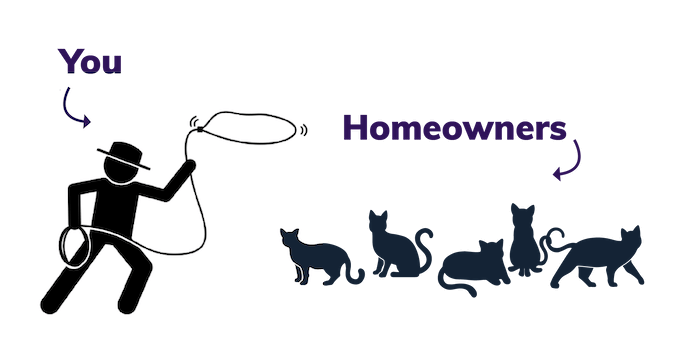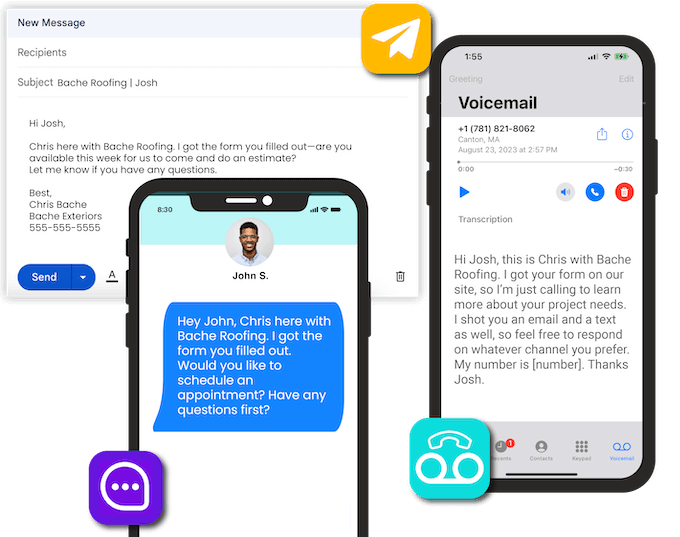Getting leads and prospects to respond is like herding cats. They filled out a form, they're qualified leads, so why aren't they picking up the phone??

This post covers the six reasons why they're not responding and what you can do to change that.
6 reasons your leads aren't answering or responding (and how to change that)
You spend too much money on marketing to reach only 20-30% of the leads you're paying for. Here's how you can improve that number to 70-80%.
1. You’re not using multiple channels
If you’re only using one channel, your chances of getting a response are going to be slim at best. Some people neglect their inboxes, others avoid phone calls at all costs. And yet others forget things easily.
When you reach out to a prospect or lead across multiple channels, you:
- Make more than one impression. The more familiar a customer is with a brand, the more it will remember and trust it.
- Demonstrate your diligence. Make a great first impression.
- Give them options to choose from. The channel most convenient for them may vary depending on when they’re able to respond.
- Activate reciprocity bias. When someone is making efforts to reach out, we feel a natural pull to reciprocate.

All of these advantages not only increase the chances of reaching a lead, but also of getting a response.
2. You’re not texting them
Most, if not all, of our customers are hesitant about business texting at first. After all, phone call has been the industry standard for years. But once they start seeing the results, they’re kicking themselves for not adopting text sooner.
If your multi-channel strategy doesn’t include text, you’re putting yourself at a disadvantage. Think about it:
- If they submitted a form online, that means they had the option to call you but didn’t—indicator #1 that phone conversation may not be their first choice.
- You’re doing your outreach while they’re at work, where they are much more likely to read and answer a text than to pick up a phone call.
- Text is often just the bridge, used to establish contact and then identify a good time to talk from there.
And if you’re not yet convinced as to why you should use text, let’s go over the numbers:
- 80% of people ignore calls from numbers they’re not familiar with (even local numbers)
- 69% of consumers would prefer an unfamiliar company to reach them via text rather than call.
- 90% of texts are opened and read within 3 minutes
- 99% of those texts are replied to
- 90% of people want to have text conversations with businesses.
The most successful call centers are using texting today. No reason you can't be one of them.
3. You’re not leading with text
So maybe you are using text in your strategy. But it’s manual, or a one-off, as-needed or depends-on-the-rep kind of deal. This is not doing you any good. You won't reap the full benefits of text messaging for your home improvement business.
The key stat above is that 90% of texts are opened and read, and 99% of those opened and read texts are responded to.
The entire sales process does not have to happen over text.
It’s just the response that you’re looking for. Then you can establish their preferred method of communication from there.
Rather than calling first and then following up with text and email, text first and accompany that text with an email and ringless voicemail. People really don’t want to converse on the phone with someone they don’t know yet. These methods make it easy for them to respond to you in a way that’s comfortable for them.
4. You’re not reaching out fast enough
When a person becomes a lead for your business, you have 5 minutes before your chances of converting them decrease drastically.
By 900% actually...
This is for many reasons:
- Lead aggregators give the same leads out to 4-5 companies at once.
- Consumers are vetting multiple vendors at once.
- 78% of people go with the business that contacted them first.
- They expect a response within 10 minutes.
So how do you increase your speed to lead?
- Define roles. Instead of having sales reps take inbound leads, have a dedicated inbound lead owner who then schedules the meetings between leads and sales reps.
- Set goals. Review your KPIs as a team on a regular basis. The numbers will hold sales reps accountable as well as enable them to set goals.
- Educate your reps. Sales reps are driven by numbers and performance. Sharing the data behind why speed to lead is important may incentivize them.
- Have a CRM. One source of truth that integrates with all of your other marketing and communication tools is essential for reaching out quickly and with context.
- Automate it. If you automate that initial outreach, not only does this save hours of manual work, but it also ensures that every lead is contacted. And now your reps have the time to engage with the people who are responding.
5. You’re giving up too soon
It takes an average of eight attempts to reach a contact. But no, this does not mean calling them eight times in a row (and hopefully you are taking my advice and staying away from real-time calls anyway). It means reaching out over the course of several days (across those multiple channels we covered earlier).
For example:
- Day 1: one text, one email, and one ringless voicemail drop
- Day 2: one text
- Day 3: one text, one email
- Day 4: pause
- Day 5: one text, one voicemail
This way, you’re being persistent, not pesky. Diligent, but not disruptive. Attentive, but not annoying. I could keep going here…
This is just an example—what works best will depend on your business and channels. But the bottom line is, it takes several attempts to get a response. But it's well worth the persistence if it means more revenue.
6. Your messages are too long
So maybe you are using multiple channels and reaching out multiple times. But you’re still not getting responses. Let me ask: Are your messages:
- Longer than 40 words?
- About your business only?
- Devoid of any questions?
If you’re bombarding them with enough text to go on a landing page or your about us page, you’re turning them away. Don’t make work for them.
Communicating with new business leads is an art.
No:
Yes:
An example of a good outreach text or email looks something like this:
Hi [Name], it's [Name] with [Company]. I got your form and wanted to get you scheduled for an appointment. When is a good time for you? Or do you have any preliminary questions?
It’s short. Easy to read. Focused on the customer. It invites a response.
Get more responses, grow your revenue
The one-call close is just not a thing anymore. Customers aren’t going to pick up a phone call, but they will respond to messages—the right messages at the right times, that is. Use the tips in this guide and you’ll be seeing a lot more responses (which means higher ROI)!
Here's a recap:
- Use multiple channels
- Make sure that includes text
- Have a text-first strategy
- Reach out within five minutes
- Keep reaching out until you get a reponse
- Stick with short messages
